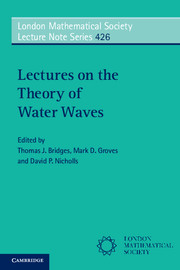Book contents
- Frontmatter
- Contents
- Contributors
- Preface
- 1 High-Order Perturbation of Surfaces Short Course: Boundary Value Problems
- 2 High-Order Perturbation of Surfaces Short Course: Traveling Water Waves
- 3 High-Order Perturbation of Surfaces Short Course: Analyticity Theory
- 4 High-Order Perturbation of Surfaces Short Course: Stability of Traveling Water Waves
- 5 A Novel Non-Local Formulation of Water Waves
- 6 The Dimension-Breaking Route to Three-Dimensional Solitary Gravity-Capillary Water Waves
- 7 Validity and Non-Validity of the Nonlinear Schrödinger Equation as a Model for Water Waves
- 8 Vortex Sheet Formulations and Initial Value Problems: Analysis and Computing
- 9 Wellposedness and Singularities of the WaterWave Equations
- 10 Conformal Mapping and Complex Topographies
- 11 Variational Water Wave Modelling: from Continuum to Experiment
- 12 Symmetry, Modulation, and Nonlinear Waves
- References
3 - High-Order Perturbation of Surfaces Short Course: Analyticity Theory
Published online by Cambridge University Press: 05 February 2016
- Frontmatter
- Contents
- Contributors
- Preface
- 1 High-Order Perturbation of Surfaces Short Course: Boundary Value Problems
- 2 High-Order Perturbation of Surfaces Short Course: Traveling Water Waves
- 3 High-Order Perturbation of Surfaces Short Course: Analyticity Theory
- 4 High-Order Perturbation of Surfaces Short Course: Stability of Traveling Water Waves
- 5 A Novel Non-Local Formulation of Water Waves
- 6 The Dimension-Breaking Route to Three-Dimensional Solitary Gravity-Capillary Water Waves
- 7 Validity and Non-Validity of the Nonlinear Schrödinger Equation as a Model for Water Waves
- 8 Vortex Sheet Formulations and Initial Value Problems: Analysis and Computing
- 9 Wellposedness and Singularities of the WaterWave Equations
- 10 Conformal Mapping and Complex Topographies
- 11 Variational Water Wave Modelling: from Continuum to Experiment
- 12 Symmetry, Modulation, and Nonlinear Waves
- References
Summary
Abstract
In this contribution we take up the question of convergence of the classical High-Order Perturbation of Surfaces (HOPS) schemes we introduced in the first lecture. This is intimately tied to analyticity properties of the relevant fields and Dirichlet–Neumann Operators. We show how a straightforward approach cannot succeed. However, with a simple change of variables this very method delivers not only a clear and optimal analyticity theory, but also a stable and high-order numerical scheme. We justify this latter claim with representative numerical simulations involving all three of the HOPS schemes presented thus far.
Introduction
Over the past two lectures we have derived several High-Order Perturbation of Surfaces (HOPS) schemes for the numerical simulation of (i.) solutions to boundary value problems, (ii.) surface integral operators (e.g., the Dirichlet–Neumann Operator [DNO]), and (iii.) free and moving boundary problems (e.g., traveling water waves). These HOPS methods are rapid (amounting to surface formulations accelerated by FFTs), robust (for perturbation size sufficiently small), and simple to implement (Operator Expansions is a one-line formula, while Field Expansions (FE) is two lines!). The derivation of all of these schemes is based upon the analyticity of the unknowns, but we have not yet specified under what conditions this is true. In this contribution we describe a straightforward framework for addressing this question that can be extended to give the most generous hypotheses known.
The first result on analyticity properties of DNOs with respect to boundary perturbations is due to Coifman & Meyer [1]. In this work the DNO was shown to be analytic as a function of Lipschitz perturbations of a line in the plane. Using a different formulation Craig, Schanz, and Sulem [2] and Craig & Nicholls [3, 4] proved analyticity of the DNO for C1 perturbations of a hyperplane in three and general d dimensions, respectively. All of these results depend upon delicate estimates of integral operators appearing in surface formulations of the problem defining the DNO.
Using a completely different approach (which we describe here), the author and F. Reitich produced a greatly simplified approach to establishing analyticity of DNOs and their related fields (at the cost of slightly less generous hypotheses, C2 smoothness of the boundary perturbation) [5–7], which has the added benefit of generating a stabilized numerical approach.
- Type
- Chapter
- Information
- Lectures on the Theory of Water Waves , pp. 32 - 50Publisher: Cambridge University PressPrint publication year: 2016



